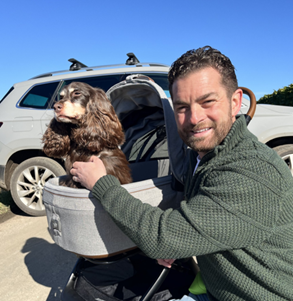We buckle ourselves in without thinking. We click the kids’ seatbelts without a second thought. But when it comes to our dogs, many of us pop them in the back, pat their head, and set off believing that love and good intentions are enough.
I’ve been guilty of it myself. Because when you’re juggling training days, family life, and a dog that can’t wait to get going, it’s easy to assume everything will be fine.
But what if it isn’t?
Recently, I sat down with two of the UK’s most respected experts to talk about the hidden dangers of unrestrained dogs in cars:
Dr Scott Miller, the UK’s best-known TV vet, with over 25 years of experience treating animals and campaigning for their welfare. You’ll have seen him on ITV’s This Morning and Crufts, and countless other programmes.

Adem Fehmi, a leading canine behaviourist and trainer who’s appeared on Channel 4, BBC Breakfast, and Love Your Weekend, and who runs one of the largest behaviour centres in the country.

This is a conversation every dog owner needs to hear. Because the risks are much greater, and far more common, than most of us realise.
The Statistics That Stop You in Your Tracks
Dr Scott shared research that paints a sobering picture:
-
In a 30mph crash, a 20kg dog (about the size of a Cocker Spaniel) becomes a 600kg projectile.
-
A 10kg dog in the back seat can hit with a force of 300kg—as much as a polar bear slamming into the front seats.
-
It’s estimated that up to 80,000 dogs die on UK roads every year, many because they were unrestrained.
That statistic alone is devastating.
Even more worrying, over half of drivers admit they regularly travel with their dogs loose.
In fact, among 18- to 24-year-olds, 86% say they’ve let their dog ride on their lap or roam freely in the car.
And 43% of young drivers have let their dog ride with its head out of the window—something that not only risks ejection and severe trauma but is also illegal.
Dr Scott told me bluntly, “People would never dream of driving without strapping their child into a seatbelt, but somehow they think it’s fine for a dog. And the consequences can be just as serious.”
The Reality of a Crash
One of the most powerful moments in our conversation was when Dr Scott described the aftermath of real crashes.
He’s seen dogs with spinal fractures, severe head injuries, and teeth embedded in dashboards. He’s treated animals thrown through windscreens.
And it’s not just the dog who gets hurt.
A loose dog can hit the driver or a passenger with hundreds of kilos of force. It can also cause the driver to swerve, leading to multi-car accidents.
In one tragic case, a dog struck the driver’s head on impact, causing a fatal crash. In another, a dog escaped from a moving vehicle, leading to a pile-up on a dual carriageway.
These are not rare horror stories. They happen every day.
Why We Let It Happen
I asked Adem why so many dog owners still take this risk.
He explained that it often comes down to emotion.
60% of people who let their dog ride on their lap say it’s because it helps them feel calm.
Among 18- to 24-year-olds, that figure rises to 76%.
Adem said, “People think they’re being kind by letting their dog sit close to them or hang their head out of the window. But what they don’t realise is that in an instant, that affection can turn into a life-threatening situation.”
He added that for working dog owners, there’s often an added layer: excitement. Dogs know when they’re going somewhere special, like a shoot or a training day. That energy can be hard to contain—and it makes them even more vulnerable in a crash.
It’s Also the Law
Many people don’t realise that travelling with an unrestrained dog is illegal.
Rule 57 of the Highway Code states that dogs must be suitably restrained so they cannot distract the driver or injure themselves or anyone else if the vehicle stops quickly.
Yet 67% of drivers don’t know they’re breaking the law.

What You Can Do Now
If you’re feeling uncomfortable reading this, you’re not alone.
But here’s the good news: small changes make a big difference.
Dr Scott and Adem shared these practical steps to keep your dog safe:
-
Use a crash-tested crate or harness. Dr Scott recommends choosing products tested to ECE R129 standards or similar. You can explore options at Tavo, a brand dedicated to pet safety.
-
Train gradually. Adem suggests introducing the crate or harness slowly at home, rewarding calm behaviour. Build up from sitting in the car with the engine off to short journeys.
-
Separate multiple dogs. If you travel with more than one dog, secure them separately to prevent distractions and reduce stress.
-
Avoid letting dogs put their head out of the window. Not only is it illegal, but it risks serious injury from debris or falls.
Dr Scott told me, “The anxiety of getting used to restraint is nothing compared to the trauma of a crash. Your dog will adapt—and you’ll have peace of mind.”
Resources You Can Trust
If you want to learn more or get support, here are some trusted sources:
A Final Thought
I’m proud that the Ladies Working Dog Group is a place where we can have these honest conversations—without judgement and without blame.
Because if we know better, we can do better.
If you’d buckle your children, you must buckle your dog. It’s that simple.
If this post has made you think differently about how your dog travels, I hope you’ll take the next step—whether it’s buying a harness, booking a training session, or sharing this article with someone who needs it.
That one decision could save a life.
If you have questions or want to share your experiences, please leave a comment or join our Facebook group. We’re here to learn and support each other—always.
Join Our Online Community!
Jump on our email list for free tips and insights delivered to your inbox monthly. No spam - just quick bites of value.

